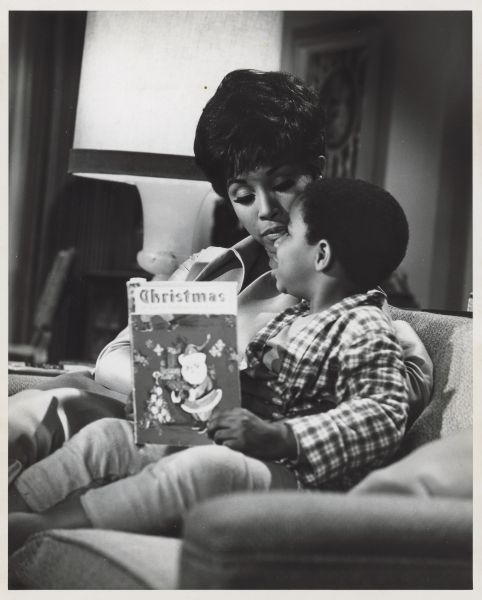
When I first visited UW-Madison as a prospective student, I had the chance to spend some time in the WCFTR. I did not initially realize campus had this wealth of historical content framing the trajectories of broadcast television and film, and once I knew it was there, I looked forward to getting back once I started as a PhD student. During my first year on campus, I was jazzed to get back to a collection I’d briefly seen during my visit–the papers of television producer and writer, Hal Kanter. As someone who’s particularly interested in studying axes of marginalized identity as they appear in mass media spaces, I was interested in diving more deeply into the collection of the creator of one of the first primetime broadcast shows with a Black female lead, Julia (NBC, 1968-1971).
I found that Kanter had worked in leadership positions on several of the programs of the 1960s and 1970s that began to engage directly with representations of racial diversity on television. I took a fairly inductive approach to my search through the Hal Kanter papers finding aid, but once I found his television-specific material (located in part two of the two-part collection) and came across his work related to Julia, a show starring the iconic Diahann Carroll, I knew I wanted to spend more time looking into an industrial perspective related to creating and advocating for the first broadcast television show fronted by a Black female lead. I started sifting through several boxes specifically pertaining to Kanter’s work developing, writing, and promoting Julia, hoping to think through answers to a few very broad research questions: were there any visible particularities to industrial considerations about a sitcom starring a Black woman? How prominently does the consideration of identity or identity politics figure into conversations between network executives and writers and sponsors? Is there anything noteworthy about the framing of Julia from an industrial or audience perspective that will illuminate how considerations of representation of racial diversity operated in mainstream televisual spaces during the time period?
The collection itself is a combination of materials from two different installments, organized by time period: part one is designated the “Original Collection” and contains materials from 1937-1972; the second part is called “1977 Additions,” and contains materials from 1959-1972. The collection contains scripts, general correspondence, legal papers, records of speaking engagements, and records of work on television shows, films, cartoons, and radio. Most of it is content that Kanter himself engaged with in some capacity. The collection was presented to the archive by Hal Kanter in 1972 and 1977, respectively. A fascinating aspect of filtering through any collection is thinking about the perspective of the submitter and what story they are interested in telling and preserving. Since it came from Kanter himself, there is the possibility that he wanted to preserve a certain understanding or image for himself for posterity, which may have affected what was ultimately included and excluded from the collection. The collection is also obviously subject to decisions he made along the way related to what was deemed worthy of preservation.
I decided to start with the contents of the first part for my first foray into the archives so that I could do a deep dive into all things Julia that were preserved by Kanter (and his assistant, Dee, who was clearly elemental to saving and cataloging materials). I sorted through several boxes comprised of correspondence, contracts, merchandising, production, and scripts. In addition to my general research questions, I was also interested in thinking about Diahann Carroll as the lead of this groundbreaking program, and paying attention to ways in which she was present in this archival collection. The first time she came up in my search was in a letter from Hal Kanter to Mort Werner, Vice President of Programs and Talent, in which Kanter referenced being “disappointed” in both Carroll and another actress as prospects for the lead role of his program (Correspondence from Hal Kanter to Mort Werner, 31 August, 1967, US 140AN, Box 17, folder 1, Hal Kanter Papers, Wisconsin Center for Film and Theater Research, Madison, Wisconsin). It seems as though the network decided to move forward with her regardless of his opinion. Kanter also preserved a letter he later wrote to Carroll, welcoming her to the production and expressing great admiration for and excitement about her participation in his program. It is difficult, based on the materials analyzed here, to fully understand Kanter’s initial concerns, but it is fascinating to see him pivot toward courting her and attempting to secure her investment in the role. Also interesting to note are his responses to criticism from fans, related to the casting decision, in which he strongly defends Carroll’s casting and portrayal of the titular character.

Another area I was particularly interested in was the discussion of promotion and merchandising. Relationships with advertisers and sponsors are also rendered visible by the correspondence saved by Kanter. There were memos from staff working in promotion to Kanter and information from advertisers, sponsors and network executives (Young & Rubicam1, NBC’s internal teams, and General Foods representatives are all included) that begin to fill in details of how the show might have been promoted. Diving more deeply into understanding promotional strategies and putting those into conversation with comparable information about Julia’s contemporary primetime shows with non-minority leads might provide some fascinating insights about how press and advertising strategies evolved to accommodate more prominent diverse casting. Generally speaking, expanding this type of research could provide insights about attitudes and perspectives around the relationship between advertising and increased diversity on screen; at minimum, it could build out context for considerations that went into promoting Julia as a groundbreaking show about a Black family.
I found a letter to Charles C. Barry, the executive vice president of the Television-Radio department at Young & Rubicam, Inc. from the end of 1969 that illuminated some of the concerns particular to a show starring Black leads from executives and advertisers—Kanter writes to Barry, speculating about a recent fall-off in viewership, saying that “[t]here is a national fall-off in public exultation for the black movement in this country, for one: recent actions and statements from our government are acting as a cleaver between whites and blacks as much as Eldridge himself” (Box 17, folder 4). Examining this collection for additional explicit references to how Julia relates to the broader civil rights movement in the United States would be fascinating; Kanter is clearly thinking about these themes and it’s possible that more insights could be gleaned through parsing more of his public-facing statements, as well as looking at how he responds to fan letters discussing the show’s representations of Blackness on screen during the development and promotion of the show. Finding moments of tension between his more public-facing statements and his more internal ones from a production studies-oriented analytical approach could be fruitful in this regard.

Kanter’s collection, read with attention to these types of topics, provides a rich portal into a different time in the U.S. television industries. In producing the first primetime show with a Black female lead, considering the role of on-screen diversity was likely at the forefront of Kanter’s mind, and searching the archive for instances where he referenced these topics can illuminate previously unexamined considerations that went into the historic move. Further exploration of Kanter’s correspondence with advertising and NBC execs, as well as any correspondence between Carroll and Kanter, and press materials from the promotion of the show could all provide a deeper understanding of early representational decisions in the TV industry, which could in turn provide valuable insights about where we are today. Increasingly, critiques about the widespread exclusion of minorities in the entertainment industry are gathering momentum2. Advocacy groups and minorities have long commented on and demanded accountability for discriminatory representational practices from Hollywood, from Black audiences raising concerns about the character “Mammy,” portrayed by Hattie McDaniel, in Gone With the Wind in the 1930s3 to a “major series of attempts made over the period 1992-2002 to pressure the US television entertainment industry into more varied and richer presentation of people of color4”. In more recent decades, with the combined impact of public opinion increasingly favoring diversity, a more diverse U.S. population, and more public attention to Hollywood practices, some notable industrial shifts have occurred. Looking back at pivotal turning points like the creation of Julia helps further contextualize the evolution of the industry, which can hopefully further encourage progress in the TV industrial space.
Notes
- One of the country’s longest-standing advertising and marketing firms, now known as VLMY&R.
- It’s also worth noting that social media-based movements like #OscarsSoWhite have contributed significantly to this momentum.
- Petty, Miriam J. Stealing the Show: African American Performers and Audiences in 1930s Hollywood. Durham: Duke University Press, 2016.
- Beltrán, M., J. Park, H. Puente, S. Ross, and J. Downing, “Pressurizing the Media Industry.” (2005). In John D.H. Downing and Charles Husband, Representing ‘Race’: Racisms, Ethnicity, and the Media, 160-193. London: Sage.

Gee, this brings me back to my UW-Madison grad school days when as a new PhD student in CommArts I trotted over to the Historical Society and dove into the Kanter Papers at Lynn Spigel’s suggestion. I’d hoped to find all sorts of production correspondence. What I found mostly were scripts and audience letters. Initially I was disappointed. But Lynn encouraged me to work with the audience letters. I wrote a paper, it became an article, “‘Is This What You Mean By Color TV?’: Race, Gender, and Contested Meanings in NBC’s Julia,” and that pretty much launched my academic career. Glad you’ve found more to work with!